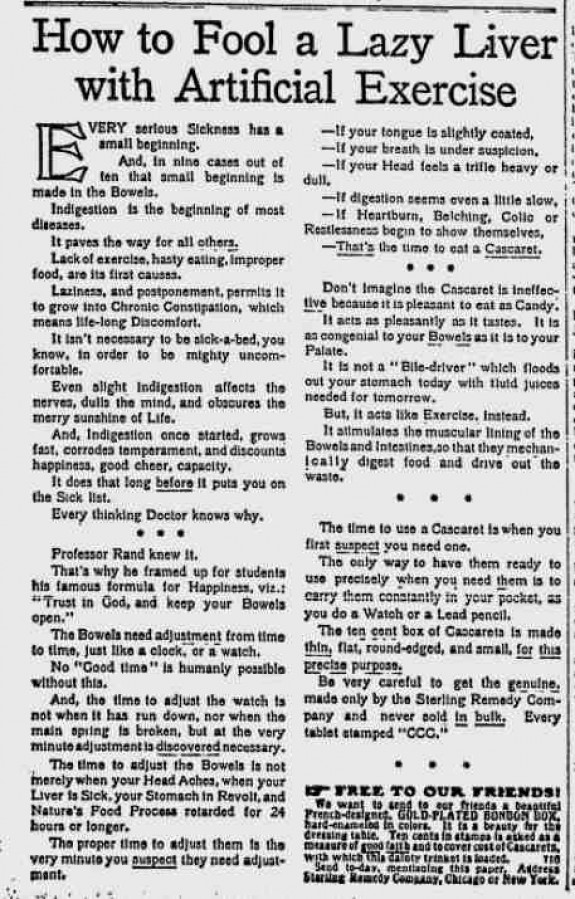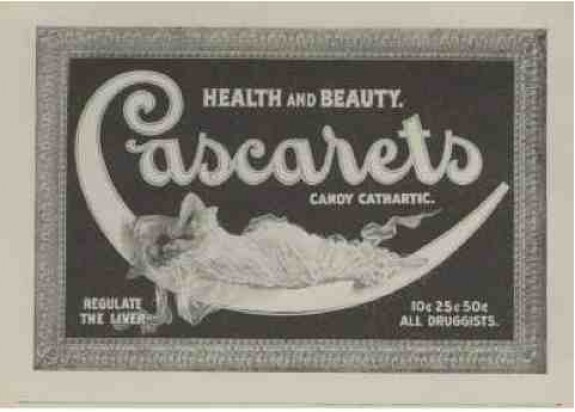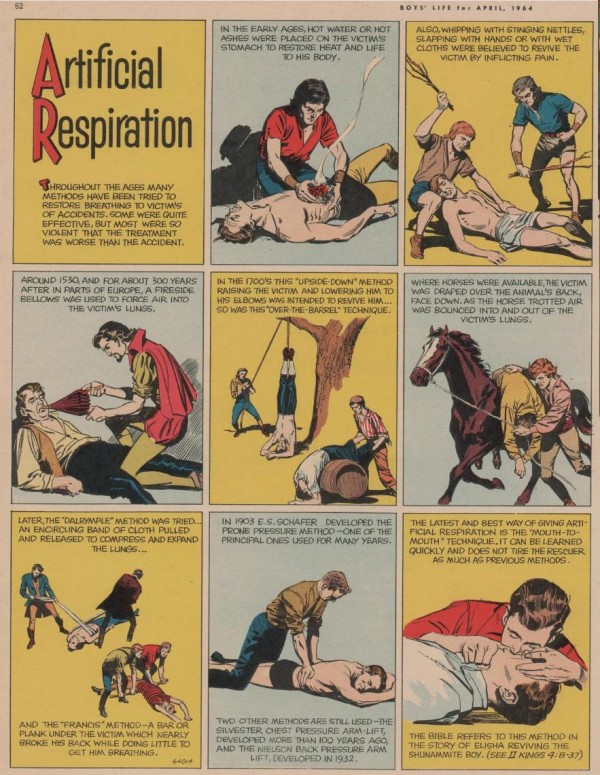Medicine
Fasting Spittle
A little bit of old-time medicine. Reported in "A Collection of Saliva Superstitions" by R. Selare, Folklore (Dec 1939), 50(4).
Posted By: Alex - Fri Jul 12, 2013 -
Comments (12)
Category: Medicine, Body Fluids
Cascarets


"Trust in God, and keep your Bowels open" is my new motto for every situation.
Original ad here.
History of Cascarets.
Posted By: Paul - Wed Apr 17, 2013 -
Comments (6)
Category: Medicine, Excrement, 1900s
Homemade Dialysis Machine Keeps Man Alive For 13 Years
Can't afford dialysis at the hospital? Get some medical equipment, sodium chloride, potassium chloride, sodium bicarbonate and purified water and ... voila!! You can get dialysis in the bathroom!!
Here's the link:
http://www.weirdasianews.com/2013/03/10/chinese-man-lives-13-years-homemade-dialysis-machine/
Seriously -- do not try this at home!! Two of this guy's friends didn't survive the experiment.
Posted By: gdanea - Mon Apr 01, 2013 -
Comments (4)
Category: Medicine
Fecal Wine, Part 2
Back in January, I posted about a Korean fecal wine named Tsongsul, which is drunk as a remedy for all manner of ills. But it turns out there's a long tradition of drinking fecal wine in the UK as well.Over at the Recipes Project, a blog about early modern recipe books, Jonathan Cey describes finding an unusual concoction in the 17th century medicinal recipe book of Johanna St. John.
And apparently Sir Robert Boyle, of the Royal Society, recommended human excrement "dried into powder, and blown into the eyes as a treatment for cataracts."
Posted By: Alex - Mon Mar 11, 2013 -
Comments (6)
Category: Food, Medicine, Excrement
Ayurvedic Remedies
Imagine what you'd smell like if you applied all three of these topical treatments at once! Probably pretty pungent. Not offensive exactly. But hungry street people with a hankering for curry would be following you and licking their lips. You might just as well roll around in your vegetable crisper and spice cabinet.
Posted By: Paul - Sat Mar 02, 2013 -
Comments (2)
Category: Body, Food, Medicine, New Age, India
Humans In Print
It is now possible to print human stem cells. Advances in organ transplantation and treatments for diseases like Parkinsons will surely be positively affected by this in time. Replicator technology coming true once again.
Posted By: Alex - Sun Feb 10, 2013 -
Comments (4)
Category: Medicine
Dr. Chase’s Nerve Food


Alvin Chase was a successful 19th-century peddler of dubious medical remedies, but his name kept being used to sell medicine throughout the 20th century. His "nerve food" contained arsenic and strychnine (and other good stuff). The Lake Country Museum has a short bio of him:
Chase only audited classes at the U-M, since Latin was required to complete the program and had not been taught at the "log school" he'd attended in New York. He earned the title "doctor" in 1857 after spending sixteen weeks in Cincinnati at the Eclectic Medical Institute.
After returning to Ann Arbor, Chase practiced medicine and continued to expand his book of recipes. To the modern reader, many of his remedies seem very quaint. Besides cures for five kinds of "apparent death," they included tinctures, teas, and ointments made from plants, tree bark, and–in one case–cooked toads. But at a time when doctors were still bleeding patients or poisoning them with mercury, his cures may have been as much help as anything the local doctor prescribed.
Posted By: Alex - Wed Feb 06, 2013 -
Comments (4)
Category: Medicine
Pubic hair grooming injuries on the rise
The article "Pubic Hair Grooming Injuries Presenting to U.S. Emergency Departments" was published in the December issue of the journal Urology. The authors note that the scientific community has paid little attention to the subject of pubic hair grooming injuries, which is why their article is a welcome correction.The take-home from the article is that a) pubic hair grooming injuries are on the rise, mostly because more people are watching porn, inspiring them to want to look like porn stars down there, so they start grooming, sometimes with bad consequences; and b) razors were responsible for most of the injuries. The authors recommend using clippers instead.

Posted By: Alex - Wed Dec 19, 2012 -
Comments (4)
Category: Hygiene, Medicine, Genitals, Hair and Hairstyling
A Brief History of Artificial Respiration
Courtesy of Boys' Life, April 1964.
Posted By: Alex - Mon Nov 19, 2012 -
Comments (2)
Category: Health, Medicine
Urine Flavor Wheels
Urine Flavor Wheels were once a standard tool used by doctors. Doctors would either sniff or taste a patient's urine to make a diagnosis. But by the 19th Century, urine tasting had fallen out of favor, replaced by the use of various chemical tests. Though some doctors resisted the change, believing that the taste test yielded more information than any chemical analysis could. More info at ediblegeography.com.
Posted By: Alex - Fri Nov 09, 2012 -
Comments (9)
Category: Medicine, Body Fluids

| Who We Are |
|---|
| Alex Boese Alex is the creator and curator of the Museum of Hoaxes. He's also the author of various weird, non-fiction, science-themed books such as Elephants on Acid and Psychedelic Apes. Paul Di Filippo Paul has been paid to put weird ideas into fictional form for over thirty years, in his career as a noted science fiction writer. He has recently begun blogging on many curious topics with three fellow writers at The Inferior 4+1. Contact Us |




